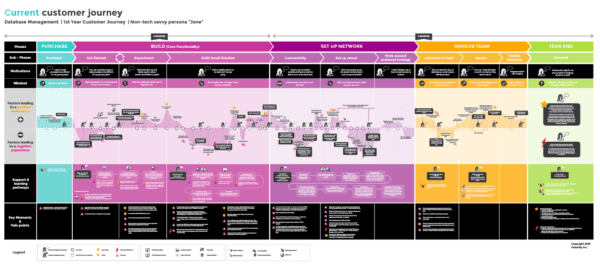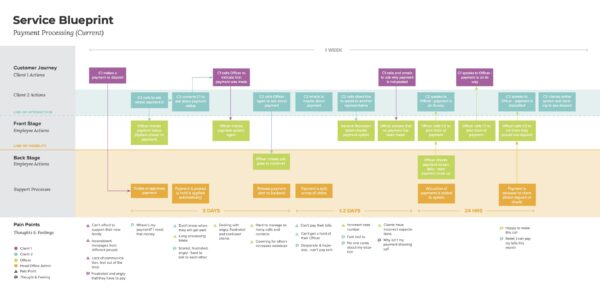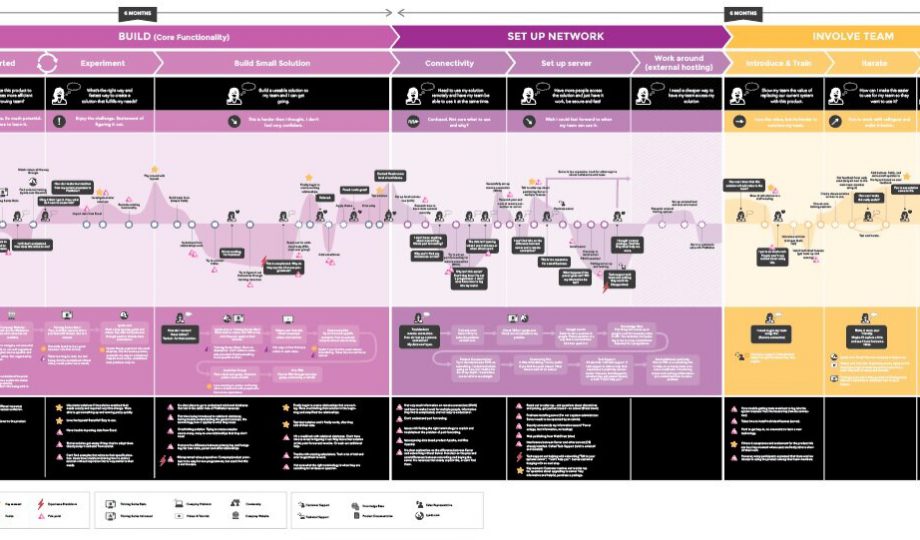Written by: Kristin Swan
Today’s post is all about championing the value of one of our all-time favourite design tools, the Customer Journey Map! A shared experience UX designers and researchers face throughout their careers is how to champion the value of Human-Centered Design (HCD). Getting executives and stakeholders on board with conducting design research and implementing new tools, like customer journey maps, can be a struggle!
As practitioners, we know that these investments are a no–brainer. Implementing human-centered design and research in your organization has endless benefits, such as enhancing customer satisfaction, improving retention, and boosting loyalty. Yet, we often see situations where teams still can’t quite convince their leaders to get on board.
So, how do we navigate this? How do we convince stakeholders and executives to invest in and implement customer journey mapping? We’re going to walk you through each step.
In this post, we will cover:
- How to Find Success With Customer Journey Mapping
- How to Sell Customer Journey Mapping to Stakeholders
- Why Customer Journey Mapping is Important for Your Bottom Line
Let’s get started!
How to Find Success With Customer Journey Mapping
As design leaders, service designers, UX designers, and design strategists, we know that journey maps are among the most valuable tools in a designer’s toolkit. They act as the baseline for design work, whether digital UX design, enterprise UX, organizational design, or large-scale strategic initiative design and facilitation.
Here at Outwitly, journey maps are foundational in our work, and we LOVE working with our clients to craft them. If you’re new to journey mapping or want to brush up on your knowledge, check out our three-part blog series to learn more about what they are, how to build them, and how to make them action-oriented!
What exactly makes them so valuable? In short, customer journey maps drive action and make change, and there are two special ingredients that power them to make a long-lasting impact on an organization.
- Personalization: First and foremost, customer journey maps are uniquely tailored for your organization, the problem you are facing, and the specific audience you are problem-solving for. They can take many forms and play many roles, but they all visually tell the story of what it’s like to be a user or customer of an organization’s product or service.
- Rigorous Research: Secondly, the foundation of any excellent journey map is the rigorous research that goes into creating it. They are never based on a single user interview but instead are the culmination of in-depth user research, often paired with extensive internal stakeholder research.
Thorough research ensures that every element in the map illuminates the actual user’s experience, challenges, frustrations, high points and low points, and in the process, highlights the most significant opportunities for an organization to capitalize on.
Thanks to these key ingredients, the maps we create at Outwitly are jam-packed with benefits to our clients, as they are designed to reveal opportunities for organizations to further capitalize on. Their action-oriented focus has helped us convince organizations to update and build new technology roadmaps, invest in new tools and tech, create more aligned multi-channel experiences, and so much more.
How to Sell Customer Journey Mapping to Stakeholders
You’re probably thinking, this all sounds great – let’s get started on customer journey mapping right away! However, you’re skipping a BIG step in this process: convincing your executives. This section of the blog will help answer the question, “How do I convince my executives and stakeholders of the value of a customer journey map?”
Adopt an HCD Mindset
Sometimes, we hear the phrase, “Once you start looking for something, you’ll find it everywhere.” For example, if we try to look for yellow cars on the highway, it’ll suddenly feel like there are thousands of them out there! We like to think similarly, but instead of thinking of yellow cars, we like to think of the HCD methodology.
When working with executives and trying to convince them of the value of journey map work, we apply HCD thinking as if these executives are our ‘users.’ We approach this task of convincing as we think about an end-user in the human-centered design process— we need to understand their needs, wants, desires, frustrations, and motivations!
Put on the HCD-coloured glasses and think: Who exactly do I need to convince? What do I know about their needs? What can I say that would alleviate their frustrations? How can I present this in a way that will motivate them?
Now that you’re thinking in a human-centered way, you’re ready to move through the HCD double-diamond phases: Discover, Define, and Design.
Discovery Phase: Desk Research and Informal Interviews
The first phase of the HCD double diamond is discovery, where you will collect insights about your executives and stakeholders to inform your storytelling and lead your value proposition strategy.
To begin your discovery, we recommend conducting quick desk research. Start by searching for your organization’s strategic goals, initiatives, priorities, or imperatives. While this information varies by organization and sector, it is typically available online or internally through quarterly strategy reviews, corporate emails, or similar channels.
Here are some great questions for your desk research:
- What are the organization’s vision, mission, and goals?
- Does the organization have any key strategies or strategic goals for the upcoming 1, 2, or 5 years?
Another tip is to conduct informal interviews with key stakeholders or the particular executive you need to convince. Frame it as a coffee chat, a “quick connect,” a one-on-one to pick their brains – whatever works in your organization’s culture. Come prepared and ask them questions. Again, put your discovery phase researcher hat on here.
Here are some great questions for your informal interview:
- What are the key priorities for the team this year?
- What is your vision?
- What are the key issues or pain points with the user experience today?
- Is there anywhere that the organization could particularly use some help?
Define Phase: What Matters the Most To Your Audience?
Now that you’ve gathered research on your stakeholder or executive, you’re onto the second phase of the HCD diamond: the define phase. Here you’ll define what matters the most to your audience.
If you work for a profit-based organization, the most important factor to the executive in question will likely be the bottom line. They’ll want to know how this investment will pay off and help them generate more money for the bottom line over time.
Customer journey maps will impact the bottom line in many different forms, such as, but not limited to:
- Improved operational efficiencies.
- Increased sales and speed of sales.
- Increased user engagement.
- Increased customer satisfaction or advocacy.
- Reduced customer turnover.
- Reduced customer service calls or overall call time.
The main takeaway here is to translate the benefits of customer journey maps to speak their language. Show them how, say, increasing user engagement will lead to increased sales and profit. You’re not simply telling them what they want to hear but illustrating exactly how and why customer journey maps will lead them there.
Design Phase: Prove Value by Speaking Their Language
Now, how do you design a message that speaks an executive’s language and highlights the benefits of customer journey maps?
Well, each of those bottom-line impacts we listed above is tracked with percentages and dollar bills – and lucky for you, many of these stats are published in reports online. We like to keep an eye out for great reports published by firms like PwC, Deloitte, and McKinsey, to name a few.
Here’s one example loaded with data you can use to help design your message. PwC conducted a research study on 15,000 consumers across 12 countries in 2017/2018 to better understand consumer buying behaviour. They found that:
- 73% of consumers expressed that customer experience is an important factor in their purchasing decisions (notably, behind price and product quality).
- 42% would pay more for a friendly, welcoming experience.
- 80% of American consumers, specifically, shared what makes a positive customer experience: speed, convenience, knowledgeable help and friendly service.
Can you see how these stats might help speak to some of your stakeholders’ needs and strategic priorities? If it wasn’t already clear, reports and percentages like these can demonstrate and emphasize the value of customer experience, and building customer journey maps = improving customer experience.
Why Customer Journey Mapping is Important for Your Bottom Line
In our work at Outwitly, we have identified four common strategic goals among our clients: improving customer experience, optimizing processes, driving innovation, and increasing revenue. Regardless of the specific objective, journey mapping can empower teams to achieve these goals, and we’ll show you how.
Improve Customer Experience
Customer experience is one of the leading decision factors for how consumers choose products and services. Whether an organization’s strategic objective is to improve customer satisfaction, decrease customer churn, or improve loyalty and retention, customer journey mapping will empower your organization to do exactly that.
Journey maps help organizations understand:
- Your customers’ or users’ biggest pain points.
- The relative importance of pain points at different touch points throughout the journey.
- The cumulative impact of the combination of pain points and challenges throughout the journey.
Once you understand your customers’ pain points, you can develop a strategy to address them. This will improve customer satisfaction, which in turn enhances retention and ultimately boosts sales and revenue.
Optimize Processes
Another critical objective we hear from almost all of our clients, regardless of sector or industry, is the need to optimize processes, reduce operational inefficiencies, and thus improve business outcomes.
For complex process optimization work, we often recommend customer journey mapping, followed by service blueprinting. Service blueprints build onto customer journey maps by going deep within the organization to map all of the “actors,” processes, systems, and tools that come together to deliver an end-to-end customer journey.
Learn the difference between customer journey maps and service blueprints here!
Drive Innovation
Customer journey maps are not just maps but an incredible window into what it’s like to walk in your customers’ shoes.
To truly reap the benefits of customer journey maps and drive innovation, we encourage teams to post (or upload) your map somewhere that’s easily accessible to everyone and consider planning workshops and activities around the map. Allow team members to brainstorm, interact, co-create, and reflect with the customer journey map, and watch as the light bulbs go off in people’s heads!
Any collaborative activity you can create will foster creativity, innovation, and growth within your organization and will likely lead to some new ideas that you (and your competition) have never considered before.
Increased Revenue
By now, it likely goes without saying that the above (improving customer experience, optimizing processes, and driving innovation) leads to increased revenue and/or business outcomes (depending on your sector).
It’s simple: the easier it is for your customers to engage with your product or service…
- The more likely they are to:
- Choose you over the competition.
- Tell their friends, family, and peers about you.
- Stay with you versus converting to the competition.
- Engage with your product or service.
- The less likely they are to:
- Need to contact your customer service department.
- Request paper files.
- Shop around.
Creating a customer journey map for your product(s) or service(s) will arm your organization with the facts directly from your users themselves. Whether it’s speed to market, winning over the competition, reducing operational inefficiencies, or the myriad of other common key strategic goals, a customer journey map is your one-way ticket to highlight the key opportunities to get there.
Now that we’ve shown you the value of customer journey maps, it’s up to you to champion the message. We hope that you are feeling armed and ready to get out there, prove the value of customer journey maps, and bring those executives on board. Good luck!









